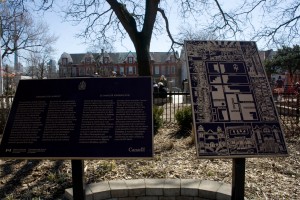Achieving National Recognition
Two main events since the 1970s demonstrate a national recognition of the historic significance of the Kensington Market neighbourhood. The presentation of a Historic Sites and Monuments Board of Canada plaque by the Honourable Jason Kenney, Secretary of State for Multiculturalism and Canadian Identity on May 25 2008 and the designation of Kensington Market as a site of national historic significance by the Historic Sites and Monuments Board of Canada in 2006 transformed the neighbourhood into a national landmark.
Historic Sites and Monuments Board of Canada Plaque (2008)
Following the presentation ceremony of the plaque in May 2008, Secretary of State Kenney affirmed the community’s distinct historical significance on behalf of Canada’s Environment Minister, John Baird by stating that: “our Government is proud to recognize Kensington Market as a national historic site. The commemoration of Kensington Market by the Government of Canada will ensure that the important history of this district will be appreciated for generations to come.” The installment of a commemorative plaque in Kensington Market constitutes an official recognition of its historic value and promotes public awareness about the community’s distinct immigrant and entrepreneurial heritage.[i]

Site of National Historic Significance Designation by the Historic Sites and Monuments Board of Canada (2006)
In 2006, the Historic Sites and Monuments Board of Canada (HSMBC) designated Kensington Market as a site of national historic significance. Established in 1919, the HSMBC assumes an advisory role to the Minister of the Environment concerning the national historic significance of locations, individuals and key events that define Canadian history. As of April 2012, 965 National Historic Sites exist and are administered by Parks Canada or other levels of government or private entities.[ii] The HSMBC granted Kensington this designation on the basis of three reasons. First, the community witnessed multiple waves of ethnic communities who have settled in Toronto since the early 20th century. Second, Kensington represents Canada’s ethnic mosaic on a micro scale. Third, the neighbourhood has developed into a unique urban district with a legacy cultural institutions and custom shops which distinguish it from the larger metropolis.[iii]
Taken together, developments in immigration, marketplace culture and historical significance that Kensington witnessed between 1970 and 2008 represent shifts in the Market’s social and historic profiles. Despite these changes, the neighbourhood’s ongoing commitment to the preservation of its historical character demonstrates that immigrant entrepreneurism and bohemian culture remain central to community life.
[i] “Government of Canada Commemorates the National Historic Significance of Kensington Market.” Canadian Corporate News, May 25, 2008. http://go.galegroup.com.ezproxy.torontopubliclibrary.ca/ps/i.do?action=interpret&id=GALE|A179375085&v=2.1&u=tplmain_z&it=r&p=CPI&sw=w&authCount=1 (accessed January 25, 2013).
[ii] Parks Canada, “Directory of Federal Heritage Designations.” Last modified 2012. Accessed January 30, 2013. http://www.pc.gc.ca/apps/dfhd/results-resultats_eng.aspx?p=1&m=10&ctl00$Main$PageSearch1$txtKeyword=&desCheck=NHS&c=&ctl00$Main$PageSearch1$ddlProvince=&dey=&ctl00$Main$PageSearch1$ddlCustodian=.
[iii] Canada’s Historic Places a Federal, Provincial and Territorial Collaboration, “Kensington Market National Historic Site of Canada Dundas West, Bellevue, Spadina, College Streets, Toronto, Ontario, M5T, Canada Formally Recognized: 2006/11/27.” Last modified 2006. Accessed January 30, 2013. http://www.historicplaces.ca/en/rep-reg/place-lieu.aspx?id=14463&pid=0.

One Reply to “Historical Significance”
Comments are closed.